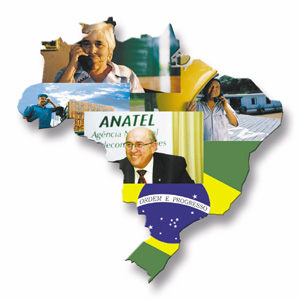

Brazil is the third in a series of five country case studies on regulatory independence and effectiveness to be presented in ITU News
Brazil is the fifth largest country in the world in terms of surface area, after Russia, China, Canada, and the United States. With a population close to 170 million, Brazil is ranked as the sixth most populous nation in the world. Brazil, the only Portuguese-speaking country in the Americas region, has by far the largest economy in Latin America with a GDP of USD 1089 billion in 2000.
In the latter half of the 20th century, Brazil took its place on the world stage as an important economic force globally, a regional leader politically and a coveted destination for foreign direct investment. Today, it is one of the most dominant emerging markets in the world.
Brazil was selected as one of five case studies for a number of compelling reasons. Above all was its ability to pass
a comprehensive telecommunication law, establish a regulator, privatize its operators and introduce duopoly competition
in a little over two years. Its regulator, the Agência Nacional de Telecomunicações (ANATEL), has been praised
by industry and other regulators around the globe as one of the most transparent and independent in the world.
|
Contributed by Doreen Bogdan-Martin, Regulatory Officer, ITU/BDT |
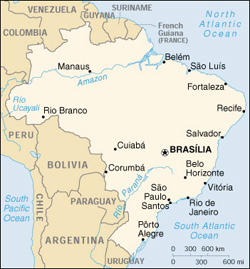
The Brazilian telecommunications model of today is built around three pillars: competition, universal service/access (known in the country as "universalization") and quality. This model has its roots in two important developments: the passage of the 1996 Minimum Law that liberalized mobile services, and the adoption of the General Telecommunications Law of 1997 that called for the creation of the regulator (ANATEL) and established guidelines for the privatization of the monopoly telecommunications provider,Telebrás. The Telecommunications Law effectively ended the State's role in the provision of telecommunication services, changing its role from supplier to regulator of services. Telebrás, which had been the monopoly provider of international, long-distance, and local services for 26 years, was broken up into twelve separate holding companies.In 1998, the government sold off 100 per cent of its interests in Telebrás, generating USD 19 billion. Immediately following privatization, ANATEL worked diligently to establish a foundation for competition in several market areas. ANATEL divided the country into a series of operating regions. In the first 18 months after privatization, the regulator successfully introduced duopoly competition into every fixed-line and cellular operating region in the country. At present, all fixed-line operators have one competitor in the region in which they operate, in addition to two competing cellular companies. The market will be open to full competition by 2002 (see Figure 1). On the mobile side, the government started auctions this year for the introduction of the Personal Mobile Service.
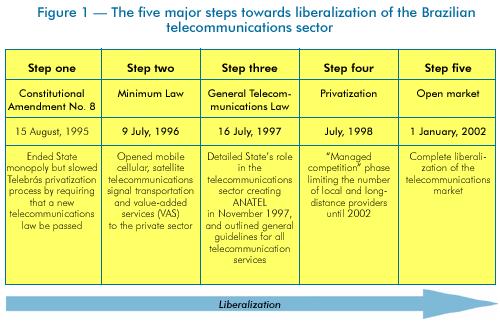
Prior to the creation of ANATEL, Brazil's Ministry of Communications (MINI-COM) was the government body responsible for regulating all telecommunication services in the country. Upon its creation in the fourth quarter of 1997, ANATEL quickly assumed MINICOM's regulatory role (with the exception of broadcasting). ANATEL was created as an administratively independent agency with financial autonomy. This autonomy has increased both regulatory responsiveness to the sector and investor confidence in the transparency and fairness of the regulatory process in Brazil.
Since privatization and the introduction of duopoly competition, the growth of the market has been spectacular. Teledensity has risen from 13 in 1998 to almost 28 lines per 100 inhabitants by the end of 2000. The cost of service activation fees declined from USD 3546 in 1990 to 28 in 2000. Mobile cellular service grew 340 per cent from 1994 to 2000. Estimates indicate that by 2005, the country will boast 58 million fixed lines, and 58 million cellular subscribers (see Figure 2).
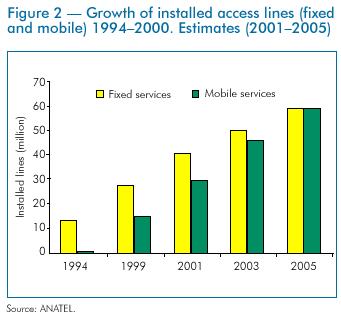
Headquartered in Brasília, with 11 regional offices, ANATEL was created to be the regulator for the citizens, to look after the public interest, and to provide investors with confidence in the Brazilian market-place.
ANATEL is made up of two high bodies — the Board of Directors and the Advisory Council. The Board of Directors, the decision-making body, has five members called counsellors. The Advisory Council is an independent body that includes congressional, Executive Branch, consumer and operator participants, and provides advice to ANATEL on policy issues. Under the Board, the 1600 ANATEL employees are organized into "Superintendencies" or departments. ANATEL strives to keep a structure that is responsive to the changing telecommunications environment. In August 2000, Congress passed a law creating the "Fund for Universalization of Telecommunications Services" (FUST). One of the purposes of FUST is to channel the necessary resources to finance the purchase and implementation of telecommunications equipment in small communities and isolated regions. With operators required to begin contributing to the Fund from 2001 ANATEL had, by mid-2001, decided to create a "Superintendency for Universalization" (universal service). Further structural changes may be made in the future to respond to convergence.
Beginning its operations just a few months after the 1997 Telecommunication Law was passed, and anticipating privatization of Telebrás within one year, ANATEL was forced to prioritize its work. It managed to author and enact regulations required to build a competitive market, oversee auctions for licences throughout the country, draft and approve new regulations governing interconnection, implement a new long-distance operator selection convention, and guide the cellular market through two years of explosive growth. ANATEL's early success, buffeted by the independence established by the 1997 Law, has resulted in a dramatic transformation of the Brazilian telecommunications competitive landscape.
Dialogue with the public is a top priority for ANATEL, and this is apparent in all its activities (see pages 26–27). Indeed, since its creation the regulator has remained committed to interacting with the public at large through a website (www.anatel.gov.br), weekly press meetings, conferences, Citizen Rooms (facilities that operate in many state capitals where any interested party can initiate a legal proceeding or make an inquiry to the agency) and call centres that handle complaints at a toll free-number that is available round the clock.
ANATEL has been empowered to oversee most telecommunications regulatory functions including licensing, tariff
approval, establishing technical standards and interconnection rates, type approval, frequency allocation, establishing
licensing fees and ensuring service quality.
Dialogue with the public — a top priority for ANATELANATEL also uses institutional campaigns to promote interaction and awareness with the public. With an 85 per cent television penetration rate in Brazilian households, television has served as an effective mechanism. In 1999, the government unveiled a campaign called "Order and Progress in Brazilian Telecommunications". The campaign was geared towards giving information to the public about the expansion and quality goals for telephony; to remind users of the obligations of operators and their right to demand compliance and to provide the public with statistics about increases in service expansion following privatization. The main media used for the campaign was television and print. The campaign consisted of a series of short commercials, with catchy images that would stick in the consumers' minds, describing telecommunications developments in simple terms. The commercials focused on fixed, mobile, and pay phone service. Each commercial ends with an expression familiar to all Brazilians "ordem e progresso" (order and progress) in Brazilian Telecommunications. This is the national motto and appears on Brazil's flag. 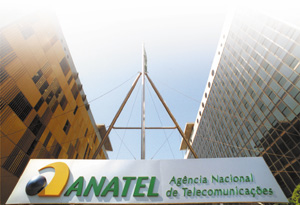 (ITU 010090) (ITU 010090)
This approach is not only very creative but also quite unique in the world of regulators. The way the campaign was designed will certainly result in a more informed consumer. In addition, the commercials serve to inform the public that there is a regulator, ANATEL, and that regulator is looking out for the interests of all Brazilian citizens. By contrast, in most countries, the average citizen may not even know if their own country has a regulatory authority, and if so what it is called. Moreover, it is unlikely that most persons not involved in telecommunication operations, policies or regulation would know that their operators have obligations, that a number of new lines will be installed, and that tariffs have decreased by a certain amount and will continue to decrease as a result of privatization and liberalization of the market. This approach of making the actions of the regulator known to the public, explaining past and present reforms and market developments, as well as the benefits for the consumer, will likely draw more citizens into ANATEL's activities. 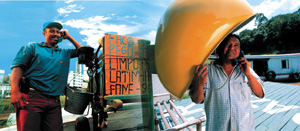
Joel Araújo Carneiro has a small business. He picks up newspapers, bottles, glasses, and provides
cleaning services. To reach him, call his cell phone. The announcer talks about ending the monopoly, the
increase in cellular phones, and the decrease in tariffs.David Carlos is on his boat in a river in the
Comunidade Ariau. Accessing the rest of the world, or linking up to the rest of the world, will take a long
time by boat. In the next scene, he gets off his boat to make a phone call at the pay phone. His link with
the rest of the world was much quicker. The commercial announces that with the privatization, the licensees
are required to install a certain number of pay phones.
The third commercial shows Dona Cecilia looking at a Christmas card from her daughter last year, and then getting a phone call from her daughter this year to wish her a Merry Christmas on her fixed-line phone. The announcer talks about the cost of phone service in the monopoly era and how the price has decreased substantially just 24 months later. It also mentions the expansion and build-out obligations of the fixed-line operators. Source for photos: Publicis Norton.
|
In Brazil, universal service embodies the principle that everyone in society, no matter their location or
socio-economic status, should have access to telecommunications.To ensure universal access and service, ANATEL
encourages competitors in the telecommunications sector to provide services of acceptable quality at commercially
reasonable rates to any physical or legal person demanding such services. Competitors are also encouraged to provide
alternative forms of access to telecommunication services with lower rates in order to guarantee access for people that
are not able to pay commercially reasonable rates.
|
ANATEL faces the challenge of complete liberalization of the market in January 2002 |
A two-pronged approach is used to achieve universal service goals. One is the implementation of the Plano Geral de Metas para a Universalização (PGMU) or "General Plan of Universalization Goals" drawn up by the Executive Branch in May 1998. PGMU establishes specific universal service goals for companies providing fixed-telephone services under the public regime (i.e., the privatized Telebrás companies). The second approach is the use of FUST, which was created to finance universal service initiatives that complement those contained in the PGMU. Allocation priorities for use of the Fund are determined by the Ministry of Communications in consultation with other Ministries. The first priorities are to use the Fund for education (Internet in schools) and health care.
ANATEL has been able to build on the positive experiences of countries that underwent the sector reform process prior to Brazil, avoiding many of their pitfalls. ANATEL's own experience has produced a number of best practices.
ANATEL, like all regulators, also faces serious challenges. A major challenge is on the personnel side — how to
find, hire, and retain qualified staff. ANATEL also faces the challenge of complete liberalization of the market in
January 2002. It will need to adapt its regulatory processes from those designed for managed competition to those
created to foster open competition.
|
A more detailed description of best practices, future challenges facing ANATEL, as well as an analysis of its overall effectiveness and independence, is available on the ITU/BDT website at www.itu.int/ITU-D/treg/Case–Studies/Index.html. |